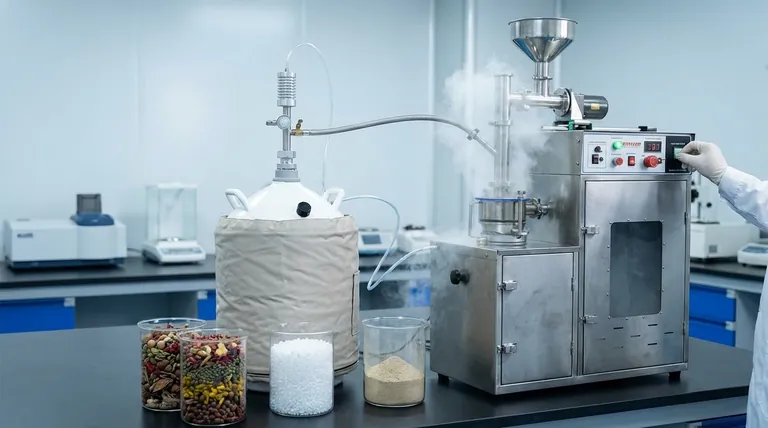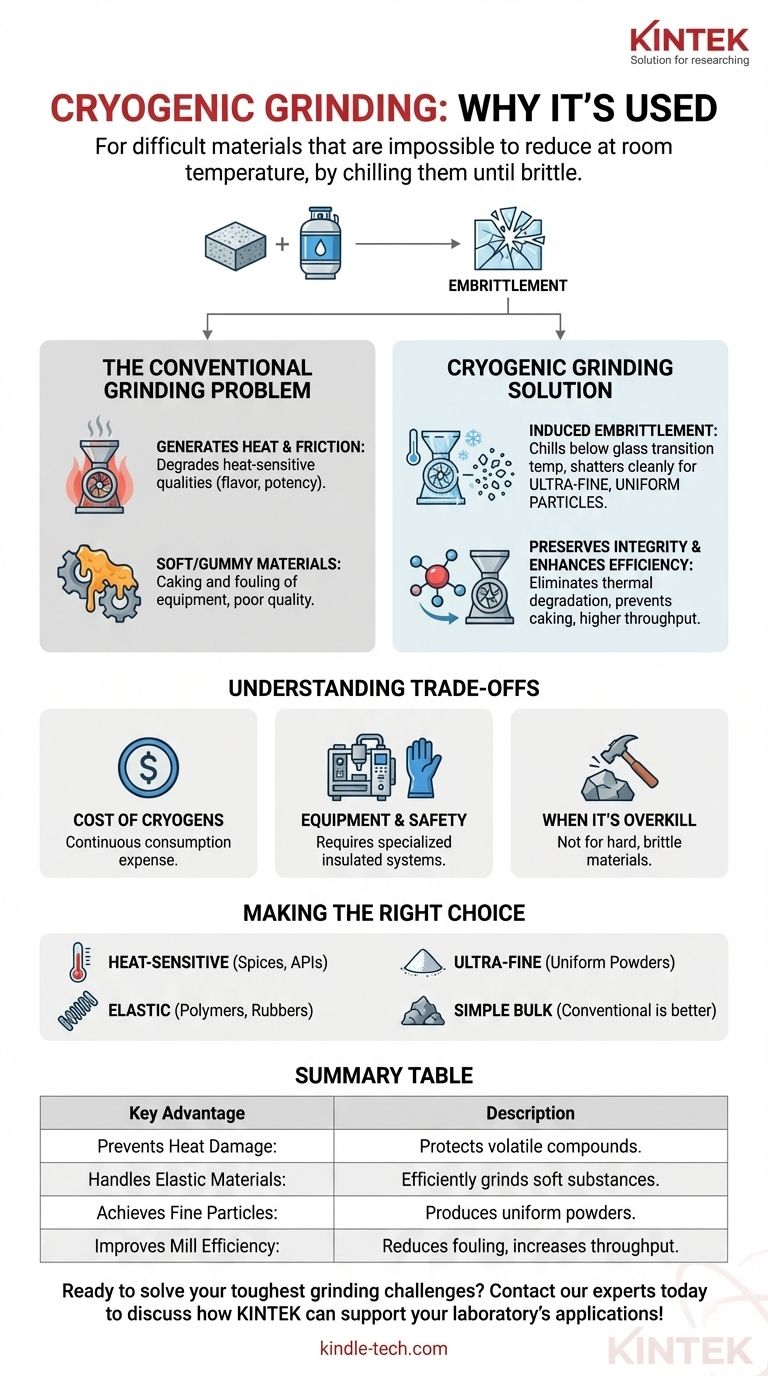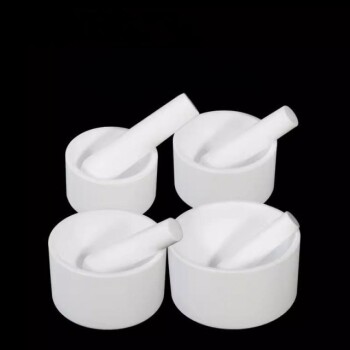本質的に、極低温粉砕は、室温ではサイズを小さくすることが困難または不可能な材料に使用されます。液体窒素のような冷媒を使用することで、このプロセスは材料を極端に脆くなるまで冷却します。この脆化により、微細で均一な粒子への効率的な破砕が可能になり、溶融、粘着、または熱に弱い成分の劣化といった問題を防止します。
極低温粉砕の主な目的は、単に材料を冷やすことではなく、その物理的特性を延性があり丈夫な状態から、硬く脆い状態へと一時的に変化させることです。この変質により、熱損傷、工具の汚染、不均一な粒子サイズといった従来の粉砕における一般的な問題を克服します。
従来の粉砕における根本的な問題
標準的な粉砕方法は、材料を分解するために機械的な力(衝撃、せん断、圧縮)に依存しています。多くの物質には効果的ですが、このプロセスはかなりの摩擦と熱を発生させます。
熱の発生とその結果
粉砕の激しいエネルギーは、その大部分が熱に変換されます。香辛料、医薬品、特定のポリマーのような熱に弱い材料の場合、これは風味、香り、化学的効力など、保存したい品質そのものを劣化または破壊する可能性があります。
柔らかい材料や粘着性のある材料の課題
多くの材料、特にプラスチック、エラストマー、ワックスは、常温ではうまく粉砕されません。破砕される代わりに、ミルの応力下で柔らかく、粘着性のある、または弾力性のある状態になります。これにより、装置の固着や汚染、生産量の低下、および劣悪な粒子品質が生じます。

極低温粉砕が問題を解決する方法
極低温粉砕は、プロセスに極度の低温を導入することで、熱と延性の限界に直接対処し、材料の挙動を根本的に変化させます。
脆化の原理
材料をガラス転移温度以下に冷却すると、その延性特性が失われ、脆くガラスのような状態になります。粉砕力が加えられると、脆化した材料はきれいに瞬時に破砕されます。これが超微細で非常に均一な粒子を達成するための鍵です。
製品の完全性の維持
システム全体が液体窒素のような不活性な冷媒で満たされているため、熱は即座に吸収されます。これにより、熱劣化が排除され、熱に弱い成分の品質が保護されます。また、酸素を置換することで酸化を防ぎ、最終製品の完全性をさらに維持します。
ミルの効率向上
材料が粘着性になるのを防ぐことで、極低温粉砕はミル内部での製品の固着を排除します。これにより、生産速度が大幅に向上し、製品単位あたりのエネルギー消費が削減され、粉砕部品の摩耗が減少します。プロセスはより高速になり、清掃のためのダウンタイムも短縮されます。
トレードオフと考慮事項の理解
強力である一方で、極低温粉砕は特定の要件を持つ特殊なプロセスです。すべての粉砕作業に対する普遍的な解決策ではありません。
冷媒のコスト
主な運用コストは、液体窒素または他の冷媒の継続的な消費です。この費用は、製品品質の向上や、他の方法では処理不可能な材料を処理できる能力といった付加価値によって正当化される必要があります。
装置と安全性の複雑さ
極低温システムには、断熱された機械、特殊な取り扱い装置、および極低温物質を管理するための厳格な安全プロトコルが必要です。初期設備投資と運用上の複雑さは、従来の粉砕設備よりも高くなります。
過剰な場合
室温で容易に粉砕される硬く脆い材料(例:鉱物、塩、セラミックス)の場合、極低温粉砕は significant な利点を提供せず、不必要なコストと複雑さを加えるだけです。
アプリケーションに適した選択をする
適切な粉砕方法の選択は、材料の特性と最終製品の目標に完全に依存します。
- 熱に弱い品質の保存が主な焦点である場合:香辛料、食品、医薬品有効成分(API)中の揮発性化合物を保護するために、極低温粉砕は不可欠です。
- 柔らかい材料や弾性のある材料の処理が主な焦点である場合:極低温粉砕は、溶融したり装置を汚染したりする可能性のあるポリマー、ゴム、ワックス、接着剤にとって優れた方法です。
- 超微細で均一な粉末の達成が主な焦点である場合:脆化プロセスにより、従来の粉砕方法では達成できないレベルの粒子サイズ制御と一貫性が可能になります。
- 単純な材料の費用対効果の高い大量削減が主な焦点である場合:熱に弱くない、または延性がない材料の場合、従来の粉砕が最も経済的で簡単な選択肢です。
サイズ縮小の目的で材料の物理状態を根本的に変えることにより、極低温粉砕は他の方法では達成できない処理能力を解き放ちます。
要約表:
| 主な利点 | 説明 |
|---|---|
| 熱損傷の防止 | 香辛料、医薬品、ポリマー中の揮発性化合物を保護します。 |
| 弾性材料の処理 | プラスチックやゴムのような柔らかく粘着性のある物質を効率的に粉砕します。 |
| 微細粒子の達成 | 材料の脆化を通じて、超微細で均一な粉末を生成します。 |
| ミル効率の向上 | 装置の汚染を減らし、処理能力を向上させ、エネルギー使用量を削減します。 |
最も困難な粉砕課題を解決する準備はできていますか? 熱に弱い香辛料、医薬品、ポリマー、またはその他の粉砕が困難な材料を扱っている場合、KINTEKの極低温粉砕ソリューションは、製品の品質を維持し、プロセスの効率を高めることができます。当社のラボ機器に関する専門知識は、お客様のニーズに合った適切なシステムを保証します。今すぐ専門家にお問い合わせください。お客様のラボの粉砕アプリケーションをどのようにサポートできるかについてご相談ください!
ビジュアルガイド

関連製品
- スクリューフィーダー付き液体窒素クライオジェニックグラインダーミルクライオミル
- ラボ用液体窒素粉砕機、プラスチック原料や熱に弱い原料の粉砕に使用
- 低温水冷タッチスクリーン振動超微粉砕機
- アルミナジルコニア製グラインディングジャー・ボール付きラボ用ボールミル
- ラボ用ハイブリッド組織粉砕機



















